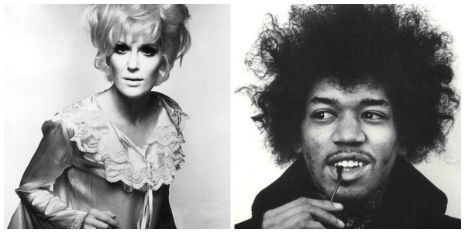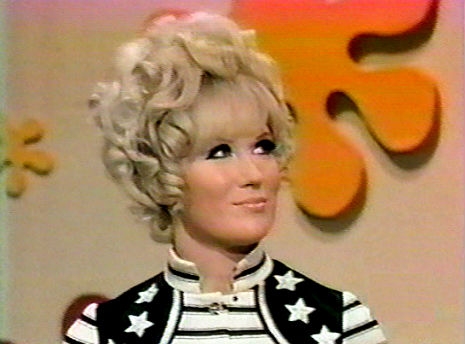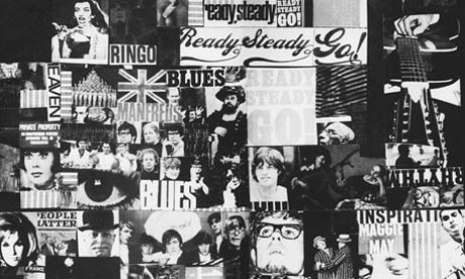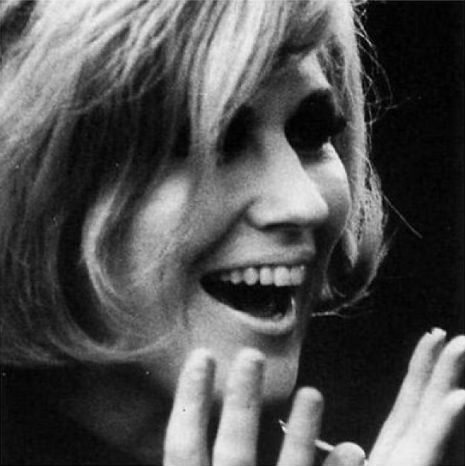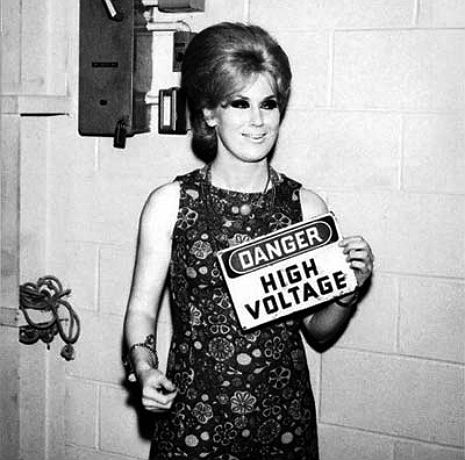
Damn straight
I adore Dusty Springfield—the voice, the pathos, the wigs, everything. But it wasn’t until I read Dusty!: Queen of the Postmods (amazing book, if you ever get the chance), that I learned about her affairs with women. That part wasn’t particularly shocking—she’s one of the great gay icons, though I assumed it was more due to her drag-ready femininity. I was, however, surprised to learn that her Sapphic tendencies were such an open secret. Of course, gossip mainly travels by whisper, and the scandalmongers often exaggerated her exploits, but Dusty’s love of the ladies was apparently quite common knowledge.
Kind of puts her appearance on The Dating Game in a whole new perspective, doesn’t it?
It wasn’t until a 1970 interview with Ray Connolly of The Evening Standard, that she decided to get candid and set the record straight. The interview is uncomfortable in places, partially because Dusty herself doesn’t seem totally comfortable with characterizing her sexuality—the language of “gay” and “bisexual” doesn’t really enter into it, and she certainly didn’t consider loving women a part of her identity at the time; she was a super-femme lady who also purported to desire men.
Tragically, Dusty’s career took a hard hit after the interview (Ironically, copping to his bisexuality was a huge boost for David Bowie’s career just two years later). Feeling hounded by the British press, she left for the US. For 15 years she didn’t have another hit, and her romantic life was incredibly turbulent. It wasn’t until a 1987 collaboration with Springfield super-fans Pet Shop Boys that her career got a boost again. She died of breast cancer in 1999, the day she was scheduled to receive the Order of the British Empire, and two weeks before her induction into the Rock and Roll Hall of Fame.
Dusty Springfield looks as though she’s playing at doctor-during-consulting-hours sitting in a white walled room at Philips Records, meeting the all and sundry members of the musical press.
I’ve never met her before, and the first thing she says is: ‘You’re sinister. Would you mind if I go to the loo before we start?’ And then with her tassles tinkling like summer 1967, she goes off down the corridor in a Mini-Ha-Ha embroidered suit, and wearing a great chunk of fancy iron and brass work around her neck which looks like something she might have pinched off a Russian Orthodox altar.
She’s thirty and hasn’t really had a big hit record for some quite considerable time. It’s a cliché but it’s true. Pop does have an awful lot of obsolescence hanging over it. She’s still singing as well as ever, dreamy and romantic, and I like her very much, but the public aren’t buying her records in the volume they used to.
Her new one is called ‘How Can I Be Sure?’ and was originally a hit in America for the Rascals. She’ll be surprised if it’s a hit for her in Britain.
‘That,’ she says, ‘comes from a backlog of doubts in myself because the last few records have gone wrong. And I’m always a bit surprised to sell records anyway. It would be a souring experience if I were not to have any more hits, but I would survive. It would be a test of character for me. I very seldom think about it, but if it did happen I’d probably get out unless I could find some other direction to go in. I don’t particularly want to be a cabaret type of entertainer. Whether or not I could be defeated into accepting that type of existence I don’t know.’
She’s plumper than I’d expected (‘I’m nine stone and I should be eight-two or eight-four. But I’m too lazy to bother about slimming’), and amazingly she still apparently buys her eyelashes by the yard, and mascara by the hundredweight. Her eyes aren’t as black as they were, she insists, looking short-sightedly through a pinkish coloured Perspex ruler at me.
‘This,’ she squints, ‘is the best colour in the world. It’s really erotic. I supposed I’ve got very erotic tastes. I like purple and magenta and all the tarty colours. I don’t wear them any more. I should go back to them because I’ve become very sedate. I’m all talk and no action. I’ve been very un-newsworthy recently. Haven’t been throwing any custard pies at anyone or anything.’
She was brought up a Catholic but never goes to Mass now. ‘It’s about six years since I made my Easter Duties. My mother’s going to love this. I still think that because I don’t go to confession I’m going to go to hell but I haven’t really done anything evil. I’m just lazy and self-indulgent.’
She’s a strange lady of contradictions. She wants me to send her a copy of an old Maureen Cleave article but she won’t give me her address. She never gives it, she insists, and then in the next breath tells me. She has a pretty, lumpy little face which looks best when she smiles. I notice she has a big shiny grey filling in her pre-molar bottom left. Her hair is the colour of dried leaves.
I think she’s a bit sad, but she says no, not at all. The last thing she wants is to be pitied. Only occasionally, when she needs someone to lean on is she lonely. Much of the time she shares her house with songwriter/painter Norma Tanega.
She is concerned that whatever I may ask her will make her sound conceited. So I suggest that she tells me her little vices, and with an enthusiasm which is almost self-destructive, she sets about it, giggling from time to time at her own ability to rattle me.
‘Well, I don’t pick my nose, but I burp like everyone else. I don’t cut my toe nails, but I pull at them and tear them off. And I’m promiscuous. Not often, but when I am, I really am. I’m not a nymphomaniac. In fact, I could do with a lot more action really. I think my laziness even spreads so far.
‘It’s an effort to be promiscuous. I don’t mean that I leap into bed with someone special every night, but my affections are easily swayed and I can be very unfaithful. It’s fun while it’s happening, but it’s not fun afterwards because I’m filled with self-recriminations. The truth is I’m just very easily flattered by people’s attentions, and after a couple of vodkas I’m even more flattered.’
She’s giggling a lot now. ‘I suppose to say I’m promiscuous is a bit of bravado on my part. I think it’s more in thought than in action. I’ve been that way ever since I discovered the meaning of the word. I used to go to confession and tell all my impure thoughts.’
Suddenly she becomes serious again, and begins to space her words out carefully and thoughtfully. ‘There’s one thing that’s always annoyed me – and I’m going to get into something nasty here. But I’ve got to say it, because so many other people say I’m bent, and I’ve heard it so many times that I’ve almost learned to accept it.
‘I don’t go leaping around to all the gay clubs but I can be very flattered. Girls run after me a lot and it doesn’t upset me. It upsets me when people insinuate things that aren’t true. I couldn’t stand to be thought of as a big butch lady. But I know that I’m as perfectly capable of being swayed by a girl as by a boy. More and more people feel that way and I don’t see why I shouldn’t.
‘There was someone on television the other night who admitted that he swings either way. I suppose he could afford to say it, but I, being a pop singer, shouldn’t even admit that I might think that way. But if the occasion arose I don’t see why I shouldn’t.
‘And yet, I get such a charge out of walking down a street and having a guy who’s digging the road give me a whistle. This business makes me feel very unwomanly sometimes and I love to be admired just for being a woman. I don’t feel masculine. If I did I’d have more drive. But being a woman is very precious to me, and that’s probably why I could never get mixed up in a gay scene because it would be bound to undermine my sense of being a woman.
‘I’ve had this reputation for years, but I don’t know how I got it. I’m always hearing that I’ve been to this gay club and that gay club. But I haven’t. I sometimes wonder if it would be nice to live up to my reputation.
‘I got raided the other day by the police. But they didn’t find any drugs. I’ve hardly ever smoked as a matter of fact. As it happens I think I know who tipped them off, and it relates to what I’ve been saying. There was a rather hysterical lady who was upset because I didn’t fancy her. I think it was her.’
She is not involved with anyone at the moment, and I wonder if she fears that she may never have a family.
‘I don’t know whether I want children or not,’ she says. ‘The urge to reproduce is always there, of course, but then I think “what for?” I probably wouldn’t be a terribly good mother. It would be great spasmodic moods of affection which don’t last and that wouldn’t be very stable.
‘I would like children psychologically and physically, although there’s something which stops me from just reproducing. But there has to be something more than what I do. There just has to be something more for me.’
I offer to take her home and out we go through the doors past the Philips records executives who smile and wave goodbye to their lady star in great hearty fashion.
‘D’you realise,’ she laughs, ‘what I’ve just said could put the final seal to my doom. I don’t know, though. I might attract a whole new audience.’
POSTSCRIPT Dusty Springfield was then, and remains, one of my favourite singers. She was one of the true witty originals of the Sixties with a beautiful voice and I hope she never regretted saying some of the things printed in this piece.
Via Ray Connolly
Below, Dusty doing “How Can I Be Sure?”










